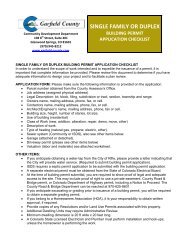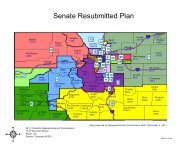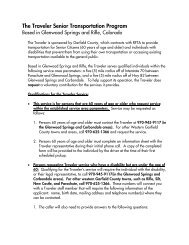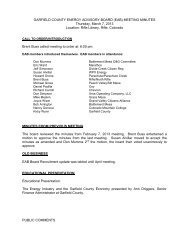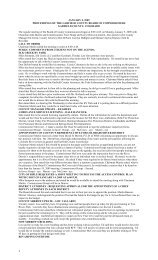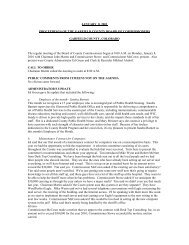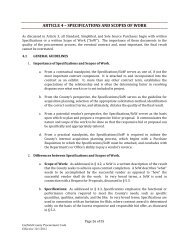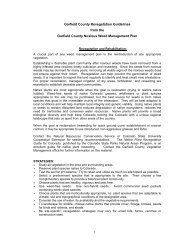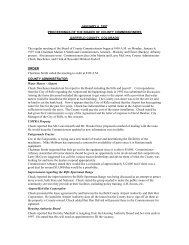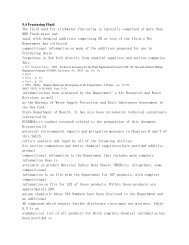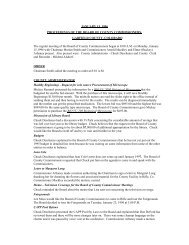Appendix D: Human Health Risk Assessment - Garfield County ...
Appendix D: Human Health Risk Assessment - Garfield County ...
Appendix D: Human Health Risk Assessment - Garfield County ...
Create successful ePaper yourself
Turn your PDF publications into a flip-book with our unique Google optimized e-Paper software.
<strong>Appendix</strong> D Screening Level <strong>Human</strong> <strong>Health</strong> <strong>Risk</strong> <strong>Assessment</strong> February 2011<br />
Battlement Mesa, Colorado <strong>Health</strong> Impact <strong>Assessment</strong> Colorado School of Public <strong>Health</strong><br />
1.2.1 2002 Community-based Short-term Ambient Air Screening<br />
Study in <strong>Garfield</strong> <strong>County</strong> for Oil and Gas Related Activities (CDPHE<br />
2002)<br />
The Colorado Department of Public <strong>Health</strong> and Environment (CDPHE) first conducted a<br />
limited screening level risk assessment using ambient air data from 20 samples collected<br />
in 2002 by the EPA in response to a request of the Grand Valley Citizen’s Alliance.<br />
Samples were collected over 24- and 8-hour intervals at wells and residences located in<br />
the Parachute valley. The samples were analyzed for 42 volatile organic compounds<br />
(VOCs) by EPA method TO-14. Maximum concentrations of acetone, methyl ethyl<br />
ketone, benzene, toluene, and xylenes (the only contaminants detected in the samples)<br />
were compared to EPA region 9 preliminary remediation goals (PRGs) for residential<br />
ambient air. PRGs are protective risk-based levels below which chronic health effects are<br />
not expected to occur. Benzene, a known human carcinogen, was the only contaminant,<br />
at a concentration of 6.5 µg/m 3 , that exceeded its PRG of 0.23 µg/m 3 . None of the noncarcinogenic<br />
VOCs were detected at concentrations that would pose a significant health<br />
risk to area residents. While the cancer risk from benzene was within EPA’s generally<br />
acceptable range of 1E-06 to 1E-04, it was greater than the 1E-06 (l cancer in a million).<br />
The report concluded benzene may warrant further review pertaining to exposure<br />
scenario assumptions and typical exposure concentrations.<br />
1.2.2 2005-2007 <strong>Garfield</strong> <strong>County</strong> Air Toxics Inhalation: Screening<br />
Level <strong>Human</strong> <strong>Health</strong> <strong>Risk</strong> <strong>Assessment</strong> (CDPHE 2007)<br />
CDPHE conducted a second more rigorous screening level HHRA in accordance with<br />
Tier-1 of EPA’s Air Toxic <strong>Risk</strong> <strong>Assessment</strong> Library (EPA, 2004) in 2007. The data for<br />
risk assessment was collected from 14 fixed air monitoring sites for 24-hour intervals on<br />
a once per month or once per quarter basis. The 14 sites were divided into three<br />
categories: Oil and Gas Development (eight sites); Urban (four sites); and Rural<br />
Background (two sites). In addition, grab samples were also collected at 27 locations<br />
based on odor complaints. All samples were analyzed for VOCs by EPA method TO-<br />
14a/15.<br />
This HHRA concluded that, the non-cancer hazards on either a chronic or short-term<br />
basis do not exceed the acceptable health based standard and the cancer risk estimates are<br />
at, or slightly above, the upper-end of EPA’s acceptable risk range (1 to 100 excess<br />
cancers per 1 million individuals). However, the HHRA identified the need for continued<br />
air monitoring and source apportionment and strongly supported the need to manage the<br />
risk posed by potential exposure of residents of the <strong>Garfield</strong> <strong>County</strong> to air toxics as a<br />
result of the dramatic increase in oil and gas development for the following reasons:<br />
(1) The estimated cancer risks and the non-cancer hazards across the rural<br />
background areas were significantly lower than those across the oil and gas<br />
development and urban areas.<br />
(2) Although total cancer risks were slightly higher in the urban areas than those in the<br />
oil and gas areas, the major contributors of cancer risk were different between the<br />
<strong>Appendix</strong> D page 5



